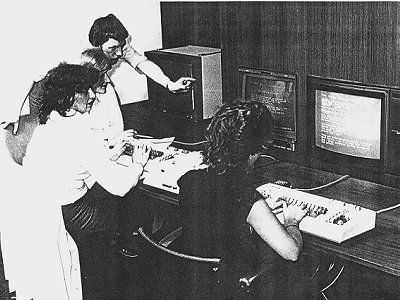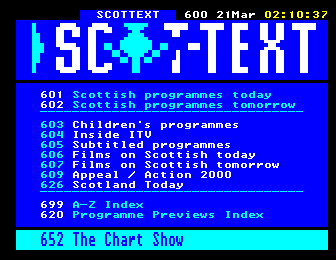 |
The Teletext Museum. |
|
|||||||||||
| STV - ORACLE'S FIRST REGIONAL SERVICE
The six months from April 1981 to October 1981 are etched in the minds and history of STV as the time of the ORACLE miracle. It was in April that the Glasgow based company agreed to become the first regional company in ITV to introduce a local teletext service. Immediately, thereafter started the finest period of co-operation between building trade craftsmen and highly skilled engineers in the Company's history. |
|
A Conference Room and offices next to the STV Newsroom was taken over and gutted, the building trades moved in and as the dust was settling the wiring squad from the Technical Department wars an the scene to lay the necessary cables.
On the day they finished the engineers arrived to install the ORACLE equipment:
Simultaneously recruitment and editorial management wars moving fast to recruit and train a totally new staff of four writers and four keyboard operators and to set up a new list of editorial contributors throughout Central Scotland.
It all happened for 'O-Day' which had been fixed as Monday October 12, 1981, and since then the service has operated without interruption.
Since the start of the ORACLE operation at STV the man with overall editorial control has been STV's Head of News, Ken Blackie who recalls on Day 1 the estimated set count in Central Scotland was 18,000. Blackie is convinced that the strength of ITV's teletext service is the unusual marriage of the ORACLE company in London and the regional television companies who collectively provide a national news and information service and an equally strong local information input.
On the plus side, the regional company knows its own area and has already long-established back-up resources to provide the kind of service required.
But on the other side of that coin, the regional company is new to teletext and is operating systems and staffing agreements designed solely for television.
The new jobs have to be slotted into the existing structure... in accordance with the local union agreement and custom and practise; salaries have to be compatible with those of existing staff in the region... and yet related to those being paid to ORACLE staff elsewhere. In STV's case, the question of priority became a regular subject for debate within the company.
"These kind of conflicts ware inevitable, although not insoluble", says Ken Blackie.
 When the first regional service went on the air
in October 1981 STV's material itself was very firmly based on news and sport,
weather and travel information .... with up-dating seven days a week, virtually
throughout television transmission times. Since, then other specialist areas
have been developed including What's On pages covering each part of the region;
business and farming news; special pages for the deaf; Yachting and skiing
information as well as the day to day television pages, and, of course, local
advertising.
When the first regional service went on the air
in October 1981 STV's material itself was very firmly based on news and sport,
weather and travel information .... with up-dating seven days a week, virtually
throughout television transmission times. Since, then other specialist areas
have been developed including What's On pages covering each part of the region;
business and farming news; special pages for the deaf; Yachting and skiing
information as well as the day to day television pages, and, of course, local
advertising.
The first reaction from those who already had teletext sets was, of course, very encouraging indeed. STV invited viewers comments and criticisms .... and had a fairly healthy response. Some of the suggestions were not only untransmittable but unmentionable. But others were very sensible indeed, and indeed certain aspects of the service have been changed as the result of letters and telephone calls from viewers.
Cross-referring between the regional and national pages proved to be very important indeed. What STV was doing was taking the full national service of three magazines and adding its own regional magazines.
Duplication and, on some occasion, even contradiction had to be watched very closely. ORACLE had the equipment to enable the London staff to access the STV magazine - and vice versa - which can be a useful facility when it comes to exchanging graphics or advertisements .... but which could also be hazardous if misused.
Close liaison on all other matters is paramount, particularly when trying to promote a relatively young medium.
At the start public reaction in the region was luke-warm. Eight out of ten people stopped in the street were not only unappreciative of ORACLE, but totally unaware of it! STV made it the next part of its job to raise that public profile in every way possible.
The fruits of those labours are reflected, both in the dramatic increase in the number of teletext sets in Central Scotland and in the way the advertising began to pick up. The sales side initially was being handled by a member of STV's existing sales staff, who was seconded part-time to receive ORACLE enquiries. It was an arrangement which just didn't work.
The sales people themselves regarded ORACLE as pretty small beer compared to television, and the agencies too were a shade disdainful. So, ORACLE Teletext rightly decided to appoint their own salesperson in Scotland, and once she began treading the streets and knocking doors, the advertising began to come in.
STV developed a very wide range of local advertising and although they were not quite yet into Births, Marriages and Deaths, they did have a thriving Classified Section selling homes and cars so on. They also started a completely new venture, unique to STV ORACLE, called the "Weekender" - a kind of classified list of where you can go at the weekends. Clubs. restaurants and pubs can run a five line massage from Thursday evening until Sunday for just £10!
Response to the advertisements is difficult to gauge - for instance two radio/electrical companies advertised cut-price televisions on ORACLE in the same week. One was very successful, while the other had no response at all!
But STV are beginning to attract larger advertisers as well, the banks, large department stores and so on and that is certain to improve as the sat count increases.
 The
final comments must lie with Ken Blackie who said "I think I would claim
relative success in the establishment of what will undoubtedly be regarded as
the blueprint for regional teletext.
The
final comments must lie with Ken Blackie who said "I think I would claim
relative success in the establishment of what will undoubtedly be regarded as
the blueprint for regional teletext.
"Our feeling of responsibility in the setting up of the first regional service was all the greater because we were aware we were going to make all the mistakes first; and we knew that we were laying down the ground-rules which others would have to follow.
"My view, and I think it's shared by most of my colleagues at STV, is that we were right to take the job on, and benefitted from getting in on the ground floor.
"There are those in the industry who are less enthusiastic about teletext but I, for one, believe that it's not going to go away".
Teletext Timeline | Teletext links
|
|||
|